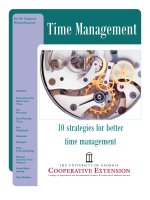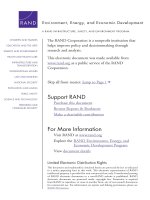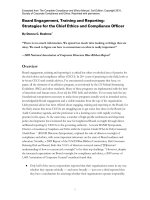Strategies for international construction related consultancy firms to compete in china
Bạn đang xem bản rút gọn của tài liệu. Xem và tải ngay bản đầy đủ của tài liệu tại đây (1.59 MB, 359 trang )
STRATEGIES FOR INTERNATIONAL CONSTRUCTION
RELATED CONSULTANCY FIRMS TO COMPETE
IN CHINA
LI SHAN
(B. Eng, Shandong Institute of Architectural Engineering;
M. Arch, Harbin Institute of Technology)
A THESIS SUBMITTED
FOR THE DEGREE OF DOCTOR OF PHILOSOPHY
DEPARTMENT OF BUILDING
NATIONAL UNIVERSITY OF SINGAPORE
2010
i
ACKNOWLEDGEMENTS
First and foremost, my deep felt thanks to my supervisor, Associate Professor
Florence Ling Yean Yng, for her inspiring guidance and continuous
encouragement throughout these four years. Without her support, this thesis
would certainly not exist. Also special thanks must go to Professor George Ofori
and Professor Low Sui Pheng, my thesis committee members, for their candid
comments and advices on my research.
Likewise, I am truly grateful to many other examiners and other professors for
sharing their knowledge with me. Special thanks to Professor Wang Shouqing,
Tsinghua university. My thanks also go to all people who responded to the
questionnaire survey.
My gratitude is also extended to all the staff in the Department of Building,
National University of Singapore, both academic and administrative, for their
continuous contributions to improve our education environment. At the same
time, the scholarship award from the National University of Singapore is
gratefully acknowledged.
Thanks to all my friends and colleagues at the National University of Singapore,
for their friendship and encouragement throughout my study.
ii
Finally, I am eternally grateful to my parents, the most important people in my
life, for their relentless support and encouragement. Also, thanks to my
husband, a good partner in my life.
iii
CONTENTS
ACKNOWLEDGEMENTS i
CONTENTS iii
SUMMARY xii
LIST OF TABLES xv
LIST OF FIGURES xvii
LIST OF ABBREVIATIONS xix
CHAPTER 1 INTRODUCTION
1.1 Background of the research………………………………………………1
1.2 Research problem and knowledge gap…………………………………2
1.3 Objectives of the research……………………………………………… 7
1.4 Scope of the research………………… ……………………… ……….8
1.5 Research hypotheses…………………………… …………………… 9
1.6 Research method…………………… …………………………………10
1.7 Significance of the research………………………………….…………12
1.8 Structure of the thesis……………………………………………………12
CHAPTER 2 LITERATURE REVIEW
2.1 Introduction……………………………………………………………….14
2.2 Western Economic concepts of competition………………………… 15
2.2.1 Industrial Organization (IO) Competition and
Structure-Conduct-Performance (SCP) analysis in industrial
economics……………………………………………………………… 15
2.2.2 Chamberlin‘s concept of Competition………………………… 17
2.2.3 Schumpeter‘s concept of Competition………………………….18
iv
2.3 Competitive strategies of Western origin………………….………… 21
2.3.1 Strategic management approach……………………………… 21
2.3.2 Competitive advantage and competitive strategy models…….24
2.3.3 Resource-based view and core competence approach………26
2.3.4 Alliance and Network strategy………………………………… 30
2.3.5 Discussion…………………………………………………………32
2.3.5.1 Assessment of classical approach to strategy………….32
2.3.5.2 Assessment of resource-based view and core
competence theory……………………………………………… 34
2.3.5.3 Western originated strategies in the international
environment……………………………………………………… 35
2.3.5.4 Definition of strategy………………………………………38
2.4 Strategic management principles of Chinese origin………………… 40
2.4.1 Cultural approach in analyzing strategies of Chinese origin….40
2.4.2 Network strategy………………………………………………….43
2.4.3 Strategic management principles from Chinese military
strategy………………………………………………………………… 44
2.4.3.1 Jiang Ziya (Taigong)'s Six Secret Strategic Teachings 48
2.4.3.2 Sun Tzu‘s Art of War………………………………………49
2.4.3.3 The Methods of the Ssu-ma…………………………… 49
2.4.3.4 Wei Liao-tzu……………………………………………… 50
2.4.3.5 Wu-tzu…………………………………………………… 50
2.4.3.6 Three Strategies of Huang Shih-kung………………… 51
2.4.3.7 Questions and Replies between T'ang T'ai-tsung and Li
Wei-kung……………………………………………………………51
2.4.4 Consideration of Chinese military strategy…………………….54
v
2.5 Strategic management in the construction industry………………… 57
2.5.1 Strategic management models in the construction industry 57
2.5.2 Strategies for operating in China‘s construction market………60
2.6 Gaps in the knowledge……………………… …………………………63
2.7 Summary………………………………………………………………….66
CHAPTER 3 CONCEPTUAL FRAMEWORK FOR FOREIGN FIRMS
TO ENHANCE COMPETITIVENESS IN CHINA
3.1 Introduction……………………………………………………………….68
3.2 Porter‘s competitive strategy and value chain…………………………68
3.2.1 Concept of business competitiveness………………………….68
3.2.2 Activity variables………………………………………………….70
3.2.3 Applications of Porter‘s frameworks…………………………….72
3.2.4 Inadequacies of the generic competitive strategies………… 74
3.3 Sun Tzu‘s Art of War…………………………………………………… 79
3.3.1 Concept of Sun Tzu‘s Art of War……………………………… 79
3.3.2 Applications of the Art of War……………………………………83
3.3.3 Inadequacies of the Art of War………………………………… 87
3.3.4 Three strategies from the dialectical perspective of the Art of
War……………………………………………………………………… 91
3.4 The Art of War and business competitiveness…………………………93
3.4.1 Swiftness strategy……………………………………………… 93
3.4.2 Adaptability strategy…………………………………………… 94
3.4.3 Market Intelligence strategy…………………………………… 96
3.5 Network strategy………………………………………………………….97
vi
3.5.1 Concept of Network strategy………………………………… 97
3.5.2 Studies in Network strategy…………………………………… 98
3.6 Conceptual framework and research hypothesis……………………102
3.7 Summary… …………………………………………………………….106
CHAPTER 4 OPERATIONALIZATION of VARIABLES
4.1 Introduction…………………………………………………………… 107
4.2 Cost leadership…………………………………………………………107
4.3 Differentiation………………………………………………………… 111
4.4 Focus…………………………………………………………………….115
4.5 Swiftness……………………………………………………………… 116
4.6 Adaptability…………………………………………………………… 120
4.7 Market Intelligence…………………………………………………… 125
4.8 Network………………………………………………………………….127
4.9 Measurement of Peformance………………………………………….132
4.10 Summary……………………………………………………………….136
CHAPTER 5 RESEARCH DESIGN AND METHOD
5.1 Introduction…………………………………………………………… 137
5.2 Research approach…………………………………………………….137
5.3 Research design……………………………………………………… 140
5.4 Exploration phase………………………………………………………141
5.4.1 Literature review…………………………………………………142
5.4.2 Data collection instrument…………………………………… 142
5.4.3 Pilot study……………………………………………………… 144
vii
5.5 Description phase………………………………………………………146
5.5.1 Data collection method…………………………………………146
5.5.2 Sampling methods………………………………………………149
5.6 Explanation phase………………………………………………………151
5.6.1 T-test analysis……………………………………………………152
5.6.2 Structural equation modeling (SEM)………………………… 153
5.6.2.1 Relationship analysis techniques………………………154
5.6.2.2 Definition of SEM……………………………………… 157
5.6.2.3 Types of SEM…………………………………………….161
5.7 PLS modelling process…………………………………………………165
5.7.1 PLS model establishment………………………………………166
5.7.2 Modelling process……………………………………………….167
5.7.2.1 Confirmatory factor analysis……………………………168
5.7.2.2 Path analysis…………………………………………… 170
5.7.2.3 Bootstrapping…………………………………………….171
5.7.3 Measurement model validation……………………………… 172
5.7.3.1 Cronbach‘s alpha reliability…………………………… 173
5.7.3.2 Item-to-total correlation…………………………………174
5.7.3.3 Composite reliability index………………………………174
5.7.3.4 AVE……………………………………………………… 175
5.7.3.5 Factor loading……………………………………………175
5.7.3.6 Rules on removal of measurement items…………… 177
5.7.4 Structural model evaluation…………………………………….178
5.8 Validation of results…………………………………………………… 179
viii
5.9 Summary……………………………………………………………… 180
CHAPTER 6 RESULTS AND DISCUSSION
6.1 Introduction…………………………………………………………… 181
6.2 Sample profile………………………………………………………… 182
6.2.1 Nature of headquarters‘ business…………………………… 185
6.2.2 Location of headquarters……………………………………….185
6.2.3 Size of workforce……………………………………………… 185
6.2.4 Revenue of firms……………………………………………… 186
6.2.5 Number of years firms have operated in China……………….186
6.2.6 Location of projects in China………………………………… 187
6.2.7 Services provided in China…………………………………… 187
6.2.8 Procurement of the services……………………………………188
6.2.9 Designation of respondents…………………………………….188
6.2.10 Number of years respondents have worked in China………188
6.3 Important practices—results of t-test………………………………….189
6.4 Critical strategies and important practices results of factor
analysis………………………………………………………………………195
6.4.1 Identification of Critical strategies…………………………… 196
6.4.1.1 EFA of Porter‘s generic strategy……………………… 197
6.4.1.2 Factors analysis of Sun Tzu‘s strategies………………201
6.4.1.3 Factors analysis of Network strategy………………….204
6.4.2 Dimensions of competitive performance…………………… 207
6.4.3 Confirmatory factor analysis results………………………… 210
6.4.4 Interpretation and discussion of findings of critical strategies
ix
underlying PSN and practices to achieve critical strategies……….215
6.4.4.1 FAC1, FAC2 and FAC3 supporting Porter‘s generic
strategy……………………………………………………………216
6.4.4.2 FAC4, FAC5 and FAC6 supporting Sun Tzu‘s
strategy……………………………………………………………219
6.4.4.3 FAC7 and FAC8 supporting Network‘s strategy…… 225
6.5 Strategies to achieve competitive performance results of PLS
analysis………………………………………………………………………227
6.5.1 Evaluation of PSN model………………………………………230
6.5.1.1 Trimming PSN model………………………………… 230
6.5.1.2 Assessment of path coefficients……………………… 231
6.5.2 Discussion of findings on strategies to achieve competitive
performance……………………………………………………………233
6.5.3 Configuration 1-strategies to achieve Y1…………………… 235
6.5.3.1 Cost Leadership (FAC3) strategy to achieve competitive
Y1………………………………………………………………… 236
6.5.3.2 Market-oriented swiftness (FAC5) strategy to achieve
competitive Y1…………………………………………………….239
6.5.3.3 Resource-network (FAC8) strategy to achieve
competitive Y1…………………………………………………….241
6.5.4 Configuration2-strategies to achieve Y2…………………… 243
6.5.4.1 Differentiation Strategies to achieve competitive Y2…245
6.5.4.2 Cost leadership strategies to achieve competitive Y2 247
6.5.4.3 Risk responsiveness strategies to achieve competitive
Y2………………………………………………………………… 249
6.5.4.4 Client-oriented swiftness (FAC6) strategies to achieve
competitive Y2…………………………………………………….252
6.6 Summary……………………………………………………………… 254
x
CHAPTER 7 MODEL VALIDATION AND APPLICATION
7.1 Introduction…………………………………………………………… 256
7.2 Designing the PSN model…………………………………………… 256
7.2.1 Quantitative performance (Y1)…………………………………256
7.2.2 Qualitative performance (Y2)………………………………… 257
7.3 Validating the PSN model………………………………………………258
7.3.1 Process of validation……………………………………………258
7.3.2 Robustness of the model……………………………………….260
7.4 Experts‘ views on the PSN model…………………………………… 264
7.4.1 Structures of the PSN model………………………………… 264
7.4.2 Practicality and comprehensiveness of the PSN model…… 268
7.5 Application of the PSN model………………………………………….270
7.6 Summary……………………………………………………………… 275
CHAPTER 8 SUMMARY AND CONCLUSIONS
8.1 Summary……………………………………………………………… 276
8.2 Summary of findings and validation of the hypothesis………………277
8.2.1 Critical strategies to attain competitive performance……… 277
8.2.2 Important practices to achieve critical strategies…………… 280
8.2.3 Model to enhance competitive performance………………….283
8.2.4. Validation of the hypothesis……………………………………284
8.3 Recommendations…………………………………………………… 284
8.3.1 Recommendations to foreign firms…………………………….285
8.3.2 Recommendations to Chinese firms………………………… 286
xi
8.4 Contribution to theory and knowledge……………………………… 287
8.5 Contribution to practice…………………………………………………289
8.6 Limitations of the research…………………………………………… 290
8.7 Conclusion………………………………………………………………293
8.8 Recommendations for future research……………………………….294
REFERENCE……………………………………………………………………296
APPENDIX-A Sample letter and survey questionnaire …………….324
APPENDIX-B-1 Model validation instrument-1……………………….330
APPENDIX-B-2 Model validation instrument-2……………………….336
xii
SUMMARY
With China being a member of the World Trade Organization (WTO), more
foreign construction-related consultancy firms (hereinafter referred to as
‗foreign firms‘) are expected to operate in China and participate in its economic
growth. The influx of foreign firms would create fierce competition between
foreign firms and Chinese construction-related consultancy firms. To succeed
in competing with the Chinese firms, foreign firms need to utilize appropriate
business strategies to enhance their competitive advantages in China. An
appropriate choice of strategies may lead to higher profits, productivity and
efficiency, and finally foreign firms may have a firm foothold in China.
The aim of this research is identify critical strategies and important practices for
foreign firms to achieve competitive performance in China‘s construction
market. The strategy for foreign firms to achieve competitive performance in
China‘s construction market is explored by integrating three perspectives:
Porter‘s generic business strategy of Western origin; principles of Sun Tzu‘s
military strategy of Chinese origin; and network strategy. The conceptual
framework is underpinned by the following strategies: Cost leadership;
Differentiation; Focus; Swiftness; Adaptability; Market Intelligence; and
Network. The developed theoretical framework postulated that foreign firms
could improve their competitive performance in China by combining the
xiii
strategies of Western and Chinese origins.
The research method is based on survey. The data collection instrument is a
structured questionnaire which is specially designed for this study. Data were
collected using mail and face to face interview approaches. In total, 37
completed questionnaires were received from senior executives of foreign
firms operating in China‘s construction market. At the data analysis stage, the
factor analysis revealed eight determinants of competitiveness: differentiation
factor; focus-training factor; cost leadership factor; risk responsiveness factor;
market-oriented swiftness factor; client-oriented swiftness factor; trust-network
factor; and resource-network factor.
Factor analysis also showed that, in China‘s construction market, foreign firms
compete in two dimensions: quantitative performance (Y1); and qualitative
performance (Y2). Y1 comprises competitiveness in being profitable, and
winning large number of project and large value of projects. Y2 comprises
competitiveness in quality, client satisfaction and public image.
Among the eight determinants, differentiation, cost leadership, and risk
responsiveness are found to have positive impacts on firms‘ qualitative
performance (Y2). Cost leadership and market-oriented swiftness have
positive impacts on firms‘ quantitative performance (Y1). Also, it is found that
client-oriented swiftness and resource-network have negative impacts on
xiv
qualitative performance and quantitative performance, respectively. Two
determinants, focus-training and trust-network, do not have significant impact
on either quantitative or qualitative performance.
This study showed that foreign firms need to adopt a combination of both
Western and Eastern strategies in order to achieve a higher level of
competitiveness in China. It is recommended that foreign firms calculate their
competitiveness level using the model developed and validated in this study to
gauge their chance of success in China. The findings also offer foreign firms
some instruments to identify important practices which may be used to help
them build up their competitiveness in China.
xv
LIST OF TABLES
Table 3.1 Competitive strategies and operationalization of strategies……… 71
Table 3.2 Sun Tzu‘s 13 chapters and some of the main precepts…………… 81
Table 5.1 Assumptions of quantitative and qualitative approaches………….138
Table 5.2 The positivist and interpretivist approaches……………………… 139
Table 5.3 Comparison of three survey instruments………………………… 147
Table 5.4 Dependence and Interdependence techniques……………………155
Table 5.5 Comparison between SME and MANOVA…………………………159
Table 5.6 The regulations and rules to remove variables…………………….177
Table 6.1 Nature of interviewees‘ firms…………………………………………183
Table 6.2 T-test of the practices and competitive performance………………190
Table 6.3 EFA of Porter‘s Generic Strategies………………………………….198
Table 6.4 Results of data reliability tests for Porter‘s Generic Strategy…… 200
Table 6.5 EFA of Sun Tzu‘s War Strategies……………………………………202
Table 6.6 Results of data reliability for Sun Tzu‘s War Strategy…………….203
Table 6.7 EFA of Network Strategy…………………………………………… 205
Table 6.8 Results of data reliability for Network Strategy…………………….206
Table 6.9 EFA of Competitive Performance……………………………………208
Table 6.10 Results of data reliability for Competitive Performance………….208
Table 6.11 Results of CFA……………………………………………………….211
Table 6.12 Correlation matrix and square root of AVE of constructs……… 214
Table 6.13 Cross loadings for individual measurement items……………… 214
Table 6.14 Inner relations (structural relationships) among constructs for PSN
model………………………………………………………………………………229
xvi
Table 6.15 Outer relations and weight relations between constructs and their
corresponding observed variables for PSN model…………………………….229
Table 6.16 Results of PSN model in trimming process……………………….231
Table 6.17 Results of F-test for R
2
in PSN model…………………………… 231
Table 6.18 Results for paths in trimmed PSN model………………………….232
Table 7.1 Profiles of the six foreign firms used to validate the models………259
Table 7.2 Weights for respective constructs………………………………… 261
Table 7.3 Comparison of actual and predicted scores……………………… 263
xvii
LIST OF FIGURES
Figure 1.1 Number of firms operating in the Chinese construction market from
2002 to 2008…………………………………………………………………… 3
Figure 1.2 Monetary output value of various firms in the Chinese construction
market from 2002 to 2008………………………………………………………… 4
Figure 1.3 Construction areas done by various firms in the Chinese
construction market from 2002 to 2008……………………………………………4
Figure 1.4 Comparison between SOEs and foreign firms in the Chinese
construction market…………………………………………………………………4
Figure 1.5 Structure of the research…………………………………………… 11
Figure 2.1 Porter‘s five-forces model…………………………………………….25
Figure 2.2 Porter‘s three generic competitive strategies……………………….25
Figure 2.3 Porter‘s value chain……………………………………………………26
Figure 2.4 Translating company performance of value chain activities into
competitive advantage…………………………………………………………….28
Figure 2.5 Types of Strategies……………………………………………………39
Figure 2.6 The seven military classics of China…………………………………48
Figure 2.7 The explanation of the knowledge gap………………………………64
Figure 3.1 From resource to market…………………………………………… 76
Figure 3.2 Contents of the conceptual framework…………………………….106
Figure 4.1 Conceptual PSN model for foreign firms to achieve comeptitive
peroformence in China………………………………………………………… 135
Figure 5.1 Types of sampling used in social research……………………… 150
Figure 5.2 Techniques to Analysis relationships………………………………156
Figure 5.3 The PLS modeling process………………………………………….166
Figure 5.4 An example of overview of CFA…………………………………….169
xviii
Figure 6.1 PLS PSN framework…………………………………………………228
Figure 6.2 Statistically significant paths in the trimmed PSN model…………234
Figure 6.3 Relationships between Cost leadership and Y1………………… 237
Figure 6.4 Relationships between Market-oriented swiftness and Y1………240
Figure 6.5 Relationships between resource-network and Y1……………… 242
Figure 6.6 Relationships between Differentiation and Y2…………………….246
Figure 6.7 Relationships between Cost leadership and Y2………………… 248
Figure 6.8 Relationships between Risk responsiveness and Y2…………….250
Figure 6.9 Relationships between Client-oriented swiftness and Y2……… 252
Figure 7.1 Checklist of the important practices and critical strategies to achieve
quantitative performance……………………………………………………… 273
Figure 7.2 Checklist of the important practices and critical strategies to achieve
qualitative performance………………………………………………………….274
xix
LIST OF ABBREVIATIONS
ANOVA- Analysis of Variance
AVE- Average Variance Extracted
CCA- Canonical Correlation Analysis
CFA- Confirmatory Factor Analysis
EFA- Exploratory Factor Analysis
JVs- Joint Ventures
MANOVA- Multivariate Analysis of Variance
MAPE- Mean Absolute Percentage Error
MPE- Mean Percentage Error
PE- Percentage Error
PLS- Partial Least Square
PSN- Porter-Sun Tzu-Network
SEM- Structural Equation Modelling
SOE- State Owned Enterprise
1
CHAPTER 1 INTRODUCTION
1.1 Background of the research
China‘s economy has made remarkable progress in recent years, and she has
maintained a Gross Domestic Product (GDP) growth rate of more than 7% for the last
eight years. In 2009, China‘s GDP hit RMB 33,535.3 billion and its growth rate reached
8.7%. In line with this growth, the contribution made by the construction industry to the
country‘s economic development should be noted. The rapid pace of economic
development brought increased pressure on the country‘s strained transportation
infrastructure and energy supply, as well as on commercial office space and residential
buildings. In 2009, investment in fixed assets and capital construction was RMB
22,484.6 billion, and the contribution of the construction industry to China‘s GDP was
5.7% (NBSC, 2010).
China‘s entrance into the World Trade Organization (WTO) has made her an attractive
foreign direct investment (FDI) destination in the foreseeable future. By amending the
existing laws and regulations to accommodate international firms, China showed her
willingness and effort to integrate into the global market and her welcome to foreign
firms, which includes construction and construction related firms. Since 1 December
2002, foreign contractors and foreign design firms have been allowed to register as
wholly foreign-owned ―construction enterprises‖ and ―construction engineering design
2
enterprises‖ respectively (MOC, 2002a, b). On 5 January 2007, the Ministry of
Construction implemented regulations for foreign-invested design enterprises to apply
for architecture, engineering and design licences in China under Decree 114. With the
issuance of Decree 114, relevant foreign firms can now apply for engineering and
design licences in China and pursue architectural, engineering or construction (A/E/C)
related opportunities.
International projects are, however, different from domestic projects. The international
construction process is marked by the combination of business and project
management skills with both mobile factors of production and location-bound support
industries (Enderwick, 1993). In addition to the typical risks of a domestic project,
international projects have a complex and subtle web of political, economic, and
cultural risks (Han et al., 2005). Therefore, foreign firms have to choose effective
strategies to deal with the environment in China in order to secure projects and
improve their competitive performance in the Chinese construction market.
1.2 Research problem and knowledge gap
The improved business environment in China has led to the increase in foreign A/E/C
firms entering the Chinese construction market. This can be seen in Figures 1.1, 1.2
and 1.3, which illustrate three aspects of firms in the Chinese construction market – the
number of firms, the monetary output value of firm, and the construction areas done by
3
the firm. But it should be noted that considering the increase of inflation during these
years, the increase of construction output value may be not so fast. The number of
foreign construction firms in the Chinese construction market has not displayed any
increasing trend in recent years. The monetary output value of these foreign firms
shows an increase in 2004, but only slight changes after 2004. The same trend of
increase can also be seen in the gross floor area constructed by foreign firms. When a
comparison is done between foreign construction firms and local state-owned
companies (SOEs) in these three aspects (see Figure 1.4), the ratios of foreign firms to
SOEs were between 0.02 and 0.07. Zhang (2003) studied the business performance
of foreign-invested construction enterprises in China and found that although there is
an increasing number of foreign-invested construction enterprise in Chinese
construction market, they had not shown strong competitiveness compared to local
firms.
Figure 1.1 Number of firms operating in the Chinese construction market from 2002 to 2008.
Source: Chinese Statistical Yearbook (2003-2009)
COLLECTIVELY-RUN’ ENTERPRISE
SOE
FOREIGN FIRM
4
Figure 1.2 Monetary output value of various firms in the Chinese construction market from 2002
to 2008.
Source: Chinese Statistical Yearbook (2003-2009)
Figure 1.3 Construction areas done by various firms in the Chinese construction market from
2002 to 2008.
Source: Chinese Statistical Yearbook (2003-2009)
Figure 1.4 Comparison between SOEs and foreign firms in the Chinese construction market.
Source: Chinese Statistical Yearbook (2003-2009)
Although China‘s entrance into the WTO reduced the barriers for foreigners to operate
in the Chinese construction market, foreign A/E/C firms still face many serious
challenges. One of the challenges is China transition from a planned economy to a
COLLECTIVELY-RUN’ ENTERPRISE
SOE
FOREIGN FIRM
COLLECTIVELY-RUN’ ENTERPRISE
SOE
FOREIGN FIRM
5
market economy along a gradual and inconsistent reform path (Jefferson et al., 1994),
unlike Eastern Europe which seeks to duplicate the structures of a Western-style
market system (Enderwick, 2004). This is the challenge for foreign A/E/C firms, since
they are required to adjust to the unfamiliar environment efficiently and effectively. The
approaches used by foreign A/E/C firms may not be same as those they used in the
Western-style market system.
Another serious challenge for foreign A/E/C firms is that they need to contend with
strong Chinese firms. More and more large Chinese construction companies are now
capable and competent to the extent that they can even venture into the international
market (Low and Jiang, 2003). According to ENR‘s (2009) report, Chinese
international construction firms have improved their performance in the overseas
market. Fifty Chinese international construction firms made their way into the list of top
225 international contractors (ENR, 2009). The overall revenue of these 50 firms is
$43.2 billion in 2008, an increase of 90% as compared to that in 2007 ($22.68 billion)
(ENR, 2008).
An additional challenge for foreign A/E/C firms is that there are unique risks in the
Chinese construction market (Ling et al., 2007). Compounding this are the high
uncertainty, fragmentation and complexity that foreign A/E/C firms would face in China
(Zhu and Hu, 2001; Shen et al., 2001; Lan and Jackson, 2002; Fang et al., 2004; and
Kang et al., 2007)









